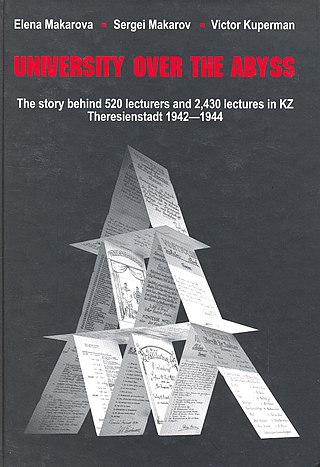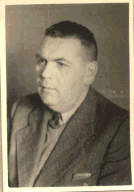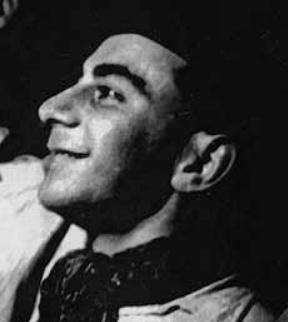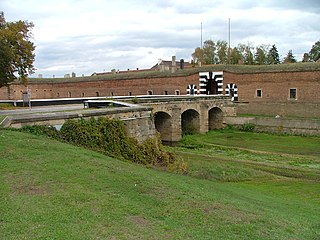
Terezín is a town in Litoměřice District in the Ústí nad Labem Region of the Czech Republic. It has about 2,800 inhabitants. It is a former military fortress composed of the citadel and adjacent walled garrison town. The town centre is well preserved and is protected by law as an urban monument reservation. Terezin is most infamously the location of the Nazis' notorious Theresienstadt Ghetto.

Kurt Gerron was a German Jewish actor and film director. He and his wife, Olga, were murdered in the Holocaust.

Theresienstadt Ghetto was established by the SS during World War II in the fortress town of Terezín, in the Protectorate of Bohemia and Moravia. Theresienstadt served as a waystation to the extermination camps. Its conditions were deliberately engineered to hasten the death of its prisoners, and the ghetto also served a propaganda role. Unlike other ghettos, the exploitation of forced labor was not economically significant.

Hans Krása was a Czech composer. He was killed during the Holocaust at Auschwitz-Birkenau. He helped to organize cultural life in Theresienstadt concentration camp.

Theresienstadt. Ein Dokumentarfilm aus dem jüdischen Siedlungsgebiet, unofficially Der Führer schenkt den Juden eine Stadt, was a black-and-white projected Nazi propaganda film. It was directed by the German Jewish prisoner Kurt Gerron and the Czech filmmaker Karel Pečený under close SS supervision in the Theresienstadt concentration camp, and edited by Pečený's company, Aktualita. Filmed mostly in the autumn of 1944, it was completed on 28 March 1945 and screened privately four times. After the war, the film was lost but about twenty minutes of footage was later rediscovered in various archives.

I Never Saw Another Butterfly: Children's Drawings and Poems from Terezin Concentration Camp, 1942–1944 is a collection of works of art and poetry by Jewish children who lived in the concentration camp Theresienstadt. They were created at the camp in secret art classes taught by Austrian artist and educator Friedl Dicker-Brandeis. The book takes its title from a poem by Pavel Friedmann, a young man born in 1921 who was incarcerated at Theresienstadt and was later killed at Auschwitz. The works were compiled after World War II by Czech art historian Hana Volavková, the only curator of the Jewish Museum in Prague to survive the Holocaust. Where known, the fate of each young author is listed. Most died prior to the camp being liberated. The original Czech edition was published in 1959 for the State Jewish Museum in Prague; the first English edition was published in 1964 by the McGraw-Hill Book Company.

Paradise Camp is a 1986 documentary film about Theresienstadt concentration camp in Czechoslovakia, written and directed by Australians Paul Rea and Frank Heimans, respectively. Czechoslovakian Jews were first told that Theresienstadt was a community established for their safety. They quickly recognized it as a ghetto and concentration camp.

University over the Abyss is a book about the educational and cultural life in the Terezín ghetto. Authors Elena Makarova, Sergei Makarov and Viktor Kuperman have searched available archives, interviewed survivors worldwide and compiled the definitive summary of this nominally illegal but extensive phenomenon that included formal lectures, poetry readings, concerts, storytelling sessions and theatrical and opera performances, all in a setting that was a holding place for prisoners who were ultimately on their way to the Auschwitz-Birkenau extermination camp.
Voices of the Children is a 1999 Emmy-Award winning documentary film written and directed by Zuzana Justman. It tells the story of three people who were imprisoned as children in the Terezin concentration camp. It was produced and shown on television in the United States.
Spuren nach Theresienstadt / Tracks to Terezín is a film with Herbert Thomas Mandl, a survivor of the Holocaust.

Karl Rahm was a Sturmbannführer (major) in the German Schutzstaffel who, from February 1944 to May 1945, served as the commandant of the Theresienstadt concentration camp. Rahm was the third and final commander of the camp, succeeding Siegfried Seidl and Anton Burger. He was hanged for war crimes.

The Ghetto Swingers were a jazz band organised in the Nazi concentration camp Theresienstadt.

Helga Hošková-Weissová, also Helga Weiss, is a Czech artist, and a Holocaust survivor. She is known for her drawings that depict life at Terezín and her diary, which was published in 2013.

Benjamin Israel Murmelstein was an Austrian rabbi. He was one of 17 community rabbis in Vienna in 1938 and the only one remaining in Vienna by late 1939. An important figure and board member of the Jewish group in Vienna during the early stages of the war, he was also an "Ältester" of the Judenrat in the Theresienstadt concentration camp after 1943. He was the only "Judenältester" to survive the Holocaust and has been credited with saving the lives of thousands of Jews by assisting in their emigration, while also being accused of being a Nazi collaborator.

Karel Švenk, sometimes referred to in German as Karl Schwenk, was a Czech cabaret artist, comedian, songwriter and writer. A leading figure in the cabaret at the Theresienstadt Ghetto, Svenk was eventually sent to Auschwitz and later to Meuselwitz. He died on a death march from Kraslice about two weeks before the end of the war. Being completely exhausted and unable to continue, his friend hid him in the straw in the barn where the prisoners spent the night. It is unknown whether he died of exhaustion or was discovered by the SS and shot.

The Small Fortress is a fortress forming a significant part of the town of Terezín in the Czech Republic. The former military fortress was established at the end of the 18th century together with the whole town of Terezín on the right bank of the Ohře River. It served as a prison in the 19th century and was also house of Imprisonment for Gavrilo Princip.

Theresienstadt was originally designated as a model community for middle-class Jews from Germany, Czechoslovakia, and Austria. Many educated Jews were inmates of Theresienstadt. In a propaganda effort designed to fool the western allies, the Nazis publicised the camp for its rich cultural life. In reality, according to a Holocaust survivor, "during the early period there were no [musical] instruments whatsoever, and the cultural life came to develop itself only ... when the whole management of Theresienstadt was steered into an organized course."
During World War II, the Theresienstadt concentration camp was used by the Nazi SS as a "model ghetto" for deceiving Red Cross representatives about the ongoing Holocaust and the Nazi plan to murder all Jews. The Nazified German Red Cross visited the ghetto in 1943 and filed the only accurate report on the ghetto, describing overcrowding and undernourishment. In 1944, the ghetto was "beautified" in preparation for a delegation from the International Committee of the Red Cross (ICRC) and the Danish government. The delegation visited on 23 June; ICRC delegate Maurice Rossel wrote a favorable report on the ghetto and claimed that no one was deported from Theresienstadt. In April 1945, another ICRC delegation was allowed to visit the ghetto; despite the contemporaneous liberation of other concentration camps, it continued to repeat Rossel's erroneous findings. The SS turned over the ghetto to the ICRC on 2 May, several days before the end of the war.

Beit Terezin or Beit Theresienstadt is a research and educational institution that opened in 1975 in Kibbutz Givat Haim (Ihud), a museum and a place of remembrance of the victims of Nazi Germany persecution at the Theresienstadt concentration camp.















